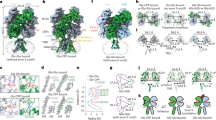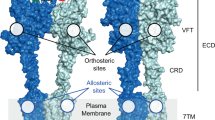Abstract
Activation of ligand-gated channels is initiated by the binding of small molecules at extracellular sites and culminates with the opening of a membrane-embedded pore. To investigate how perturbations at ligand-binding domains influence the gating reaction, we examined current traces recorded from individual NMDA receptors in the presence of several subunit-specific partial agonists. We found that low-efficacy agonists acting at either the glycine-binding or the glutamate-binding NMDA receptor subunits had very similar effects on the receptor's activation reaction, possibly reflecting a high degree of coupling between the two subunit types during gating. In addition, we found that partial agonists increased the height of all energy barriers encountered by NMDA receptors during activation. This result stands in sharp contrast to the localized effects that have been observed for pentameric ligand-gated channels and may represent a previously unknown mechanism by which partial agonists reduce receptor activity.
This is a preview of subscription content, access via your institution
Access options
Subscribe to this journal
Receive 12 print issues and online access
$209.00 per year
only $17.42 per issue
Buy this article
- Purchase on Springer Link
- Instant access to full article PDF
Prices may be subject to local taxes which are calculated during checkout





Similar content being viewed by others
References
Colquhoun, D. What have we learned from single ion channels? J. Physiol. (Lond.) 581, 425–427 (2007).
Armstrong, N., Sun, Y., Chen, G.Q. & Gouaux, E. Structure of a glutamate receptor ligand–binding core in complex with kainate. Nature 395, 913–917 (1998).
Armstrong, N. & Gouaux, E. Mechanisms for activation and antagonism of an AMPA-sensitive glutamate receptor: crystal structures of the GluR2 ligand binding core. Neuron 28, 165–181 (2000).
Grosman, C., Zhou, M. & Auerbach, A. Mapping the conformational wave of acetylcholine receptor channel gating. Nature 403, 773–776 (2000).
Robert, A., Armstrong, N., Gouaux, J.E. & Howe, J.R. AMPA receptor binding cleft mutations that alter affinity, efficacy and recovery from desensitization. J. Neurosci. 25, 3752–3762 (2005).
Lape, R., Colquhoun, D. & Sivilotti, L.G. On the nature of partial agonism in the nicotinic receptor superfamily. Nature 454, 722–727 (2008).
Mukhtasimova, N., Lee, W.Y., Wang, H.L. & Sine, S.M. Detection and trapping of intermediate states priming nicotinic receptor channel opening. Nature 459, 451–454 (2009).
Howe, J.R., Colquhoun, D. & Cull-Candy, S.G. On the kinetics of large-conductance glutamate receptor ion channels in rat cerebellar granule neurons. Proc. R. Soc. Lond. B 233, 407–422 (1988).
Gibb, A.J. & Colquhoun, D. Glutamate activation of a single NMDA receptor channel produces a cluster of channel openings. Proc. Biol. Sci. 243, 39–45 (1991).
Banke, T.G. & Traynelis, S.F. Activation of NR1/NR2B NMDA receptors. Nat. Neurosci. 6, 144–152 (2003).
Popescu, G. & Auerbach, A. Modal gating of NMDA receptors and the shape of their synaptic response. Nat. Neurosci. 6, 476–483 (2003).
Auerbach, A. & Zhou, Y. Gating reaction mechanisms for NMDA receptor channels. J. Neurosci. 25, 7914–7923 (2005).
Schorge, S., Elenes, S. & Colquhoun, D. Maximum likelihood fitting of single channel NMDA activity with a mechanism composed of independent dimers of subunits. J. Physiol. 569, 395–418 (2005).
Dravid, S.M., Prakash, A. & Traynelis, S.F. Activation of recombinant NR1/NR2C NMDA receptors. J. Physiol. (Lond.) 586, 4425–4439 (2008).
Erreger, K., Dravid, S.M., Banke, T.G., Wyllie, D.J. & Traynelis, S.F. Subunit-specific gating controls rat NR1/NR2A and NR1/NR2B NMDA channel kinetics and synaptic signaling profiles. J. Physiol. (Lond.) 563, 345–358 (2005).
Zhang, W., Howe, J.R. & Popescu, G.K. Distinct gating modes determine the biphasic relaxation of NMDA receptor currents. Nat. Neurosci. 11, 1373–1375 (2008).
Cull-Candy, S., Brickley, S. & Farrant, M. NMDA receptor subunits: diversity, development and disease. Curr. Opin. Neurobiol. 11, 327–335 (2001).
Collingridge, G.L., Olsen, R.W., Peters, J. & Spedding, M. A nomenclature for ligand-gated ion channels. Neuropharmacology 56, 2–5 (2008).
Monyer, H. et al. Heteromeric NMDA receptors: molecular and functional distinction of subtypes. Science 256, 1217–1221 (1992).
Vicini, S. et al. Functional and pharmacological differences between recombinant N-methyl-D-aspartate receptors. J. Neurophysiol. 79, 555–566 (1998).
Johnson, J.W. & Ascher, P. Glycine potentiates the NMDA response in cultured mouse brain neurons. Nature 325, 529–531 (1987).
Kleckner, N.W. & Dingledine, R. Requirement for glycine in activation of NMDA receptors expressed in Xenopus oocytes. Science 241, 835–837 (1988).
Jahr, C.E. High probability opening of NMDA receptor channels by L-glutamate. Science 255, 470–472 (1992).
Popescu, G., Robert, A., Howe, J.R. & Auerbach, A. Reaction mechanism determines NMDA receptor response to repetitive stimulation. Nature 430, 790–793 (2004).
Priestley, T. et al. Pharmacological properties of recombinant human N-methyl-D-aspartate receptors comprising NR1a/NR2A and NR1a/NR2B subunit assemblies expressed in permanently transfected mouse fibroblast cells. Mol. Pharmacol. 48, 841–848 (1995).
Sheinin, A., Shavit, S. & Benveniste, M. Subunit specificity and mechanism of action of NMDA partial agonist D-cycloserine. Neuropharmacology 41, 151–158 (2001).
Inanobe, A., Furukawa, H. & Gouaux, E. Mechanism of partial agonist action at the NR1 subunit of NMDA receptors. Neuron 47, 71–84 (2005).
Furukawa, H. & Gouaux, E. Mechanisms of activation, inhibition and specificity: crystal structures of the NMDA receptor NR1 ligand–binding core. EMBO J. 22, 2873–2885 (2003).
Chen, P.E. et al. Modulation of glycine potency in rat recombinant NMDA receptors containing chimeric NR2A/2D subunits expressed in Xenopus laevis oocytes. J. Physiol. (Lond.) 586, 227–245 (2008).
Jin, R., Banke, T.G., Mayer, M.L., Traynelis, S.F. & Gouaux, E. Structural basis for partial agonist action at ionotropic glutamate receptors. Nat. Neurosci. 6, 803–810 (2003).
Howe, J.R., Cull-Candy, S.G. & Colquhoun, D. Currents through single glutamate receptor channels in outside-out patches from rat cerebellar granule cells. J. Physiol. (Lond.) 432, 143–202 (1991).
Gibb, A.J. & Colquhoun, D. Activation of N-methyl-D-aspartate receptors by L-glutamate in cells dissociated from adult rat hippocampus. J. Physiol. (Lond.) 456, 143–179 (1992).
Furukawa, H., Singh, S.K., Mancusso, R. & Gouaux, E. Subunit arrangement and function in NMDA receptors. Nature 438, 185–192 (2005).
Erreger, K. et al. Subunit-specific agonist activity at NR2A-, NR2B-, NR2C- and NR2D-containing N-methyl-D-aspartate glutamate receptors. Mol. Pharmacol. 72, 907–920 (2007).
de Carvalho, L.P., Bochet, P. & Rossier, J. The endogenous agonist quinolinic acid and the non endogenous homoquinolinic acid discriminate between NMDAR2 receptor subunits. Neurochem. Int. 28, 445–452 (1996).
Blanke, M.L. & VanDongen, A.M. The NR1 M3 domain mediates allosteric coupling in the N-methyl-D-aspartate receptor. Mol. Pharmacol. 74, 454–465 (2008).
Erreger, K. et al. Mechanism of partial agonism at NMDA receptors for a conformationally restricted glutamate analog. J. Neurosci. 25, 7858–7866 (2005).
Schorge, S. & Colquhoun, D. Studies of NMDA receptor function and stoichiometry with truncated and tandem subunits. J. Neurosci. 23, 1151–1158 (2003).
Zhang, W., Robert, A., Vogensen, S. & Howe, J.R. The relationship between agonist potency and AMPA receptor kinetics. Biophys. J. 91, 1336–1346 (2006).
Zhang, W., Cho, Y., Lolis, E. & Howe, J.R. Structural and single-channel results indicate that the rates of ligand binding domain closing and opening directly impact AMPA receptor gating. J. Neurosci. 28, 932–943 (2008).
Sun, Y. et al. Mechanism of glutamate receptor desensitization. Nature 417, 245–253 (2002).
Howe, J.R. Desensitization at the interface. ACS Chem. Biol. 1, 623–626 (2006).
Rosenmund, C., Stern-Bach, Y. & Stevens, C.F. The tetrameric structure of a glutamate receptor channel. Science 280, 1596–1599 (1998).
Shelley, C. & Magleby, K.L. Linking exponential components to kinetic states in Markov models for single-channel gating. J. Gen. Physiol. 132, 295–312 (2008).
Acknowledgements
We thank J.M. Myers and A.M. Popescu for obtaining some of the single-channel records. This work was supported by the US National Institutes of Health (G.K.P.).
Author information
Authors and Affiliations
Contributions
C.L.K. recorded the majority of the current traces and analyzed all of the data. C.L.K. and G.K.P designed the experiments, interpreted the results and wrote the manuscript.
Corresponding author
Supplementary information
Supplementary Text and Figures
Supplementary Figures 1–4 and Supplementary Tables 1–3 (PDF 335 kb)
Rights and permissions
About this article
Cite this article
Kussius, C., Popescu, G. Kinetic basis of partial agonism at NMDA receptors. Nat Neurosci 12, 1114–1120 (2009). https://doi.org/10.1038/nn.2361
Received:
Accepted:
Published:
Issue Date:
DOI: https://doi.org/10.1038/nn.2361
This article is cited by
-
A conserved glycine harboring disease-associated mutations permits NMDA receptor slow deactivation and high Ca2+ permeability
Nature Communications (2018)
-
NMDA receptors: linking physiological output to biophysical operation
Nature Reviews Neuroscience (2017)
-
Mechanism of partial agonism in AMPA-type glutamate receptors
Nature Communications (2017)
-
The structure–energy landscape of NMDA receptor gating
Nature Chemical Biology (2017)
-
Structural mechanisms of activation and desensitization in neurotransmitter-gated ion channels
Nature Structural & Molecular Biology (2016)



